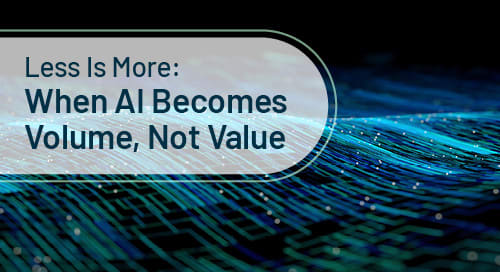Less Is More: When AI Becomes Volume, Not Value
 In recent months I’ve watched a trend in our world of organizational excellence that worries me. As AI tools like ChatGPT, Microsoft Copilot, and others have become widespread, we’re seeing emails, research, reports, slide decks, etc., that look polished but don’t move anything forward.
In recent months I’ve watched a trend in our world of organizational excellence that worries me. As AI tools like ChatGPT, Microsoft Copilot, and others have become widespread, we’re seeing emails, research, reports, slide decks, etc., that look polished but don’t move anything forward.
It’s not that AI doesn’t have a role: it absolutely does. It can help brainstorm, organize thoughts, prepare, build conversation starters, and challenge assumptions. But what’s emerging too often is heavy output and low insight.
What’s worse, some of our time is being eaten up because we have to wade through it, fact-check it, and decipher what’s real and what matters. In other words: garbage in = garbage out.
Why it matters
-
- When individuals and teams use AI to pump out lengthy emails (dashes, bold, emojis; you know the style) rather than concise, meaningful communication, the signal-to-noise ratio drops.
- As volume goes up, clarity tends to go down, meaning the receiver spends more cognitive effort, not less. This drains productivity, trust, and momentum.
- Jobs exist to drive outcomes. If most of the output is dress-up rather than decision-driving, we lose credibility and impact.
The stats I’m moving right now
-
- A recent study by the Stanford Social Media Lab with BetterUp Labs coined the term workslop. Workslop is AI-generated work content that appears polished but lacks substance. Some 41% of workers have encountered this kind of output, with each instance costing nearly two hours of downstream time to decode/fix.
- In a large organization (10,000+ workers), the workslop tax can amount to more than $9 million per year in lost productivity.
- On the flipside, the Federal Reserve Bank of St. Louis found that workers using generative AI reported average time savings of 5.4 % of work hours (~ 2.2 hours per week for the average worker) when used thoughtfully.
- But that uplift is modest, and for many organizations the net effect is still negligible because of implementation issues.
My takeaway (from where we sit)
-
- AI is powerful, but not a substitute for human thought, judgment, or execution.
- The danger is assuming a generate-first, think-second, mindset. That’s exactly what breeds volume without value.
- A better approach: ask yourself why you’re generating that email, response, or report. Then decide what minimal, high-leverage output is needed. Use AI to draft or prep but the final decision, cut, and execution must be human.
- We need to simplify communication. If an email becomes 400 words, five bullet points, bold text, dashes, and emojis, it may signal that the writer didn’t fully think through what they needed to say.
- The rule should be fewer, clearer, shorter outputs that drive next-step action. Let AI help us get to the next step faster; not create yet another doc we have to clean up.
Want a framework? Good!
-
- Define the objective: What do we want this email/report to achieve?
- Draft smart-short: Use AI to capture ideas, headings, and structure.
- Human refine: Remove fluff. Ask: Does this drive a decision or action? If not, cut it.
- Send. Execute. Follow through: Use the content as a tool, not the tool as the end.
- Review outcomes: Did the communication lead to forward motion? If not, iterate.
In a world where AI can crank out content in seconds, our job is to resist the noise and focus on what matters. Your brain, your team’s thinking, and your execution are still the value drivers. Volume is not a substitute for value. Less is more.
Let’s lead with that.
_______________________________________________________________
Editor’s Note: Interested in learning more about AI applications in today’s work environment? Explore Britney Cole’s recent presentation, Leading (and Learning) in the Age of AI. Also, be sure to check out Blanchard's new point-of-view, Leading with Humanity in the Age of AI. Both resources are free, courtesy of Blanchard. Learn more today!
